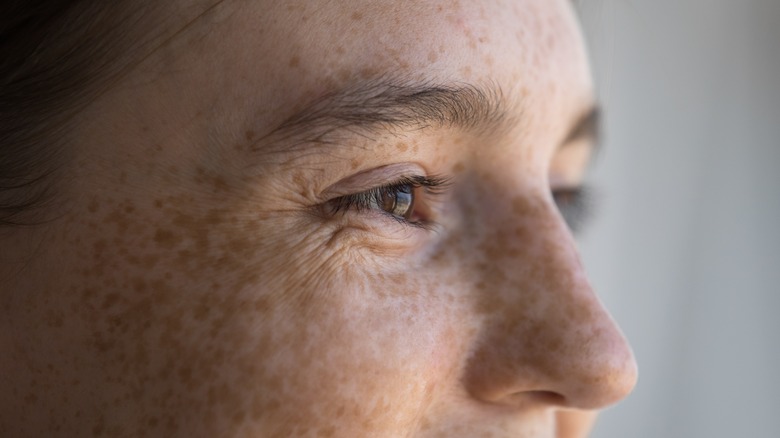Here's When You Should Be Concerned About Your Freckles
We have many words in the English language for freckles. We know them as a blot, a dapple, a dot, and a speck. Those of us with many prefer to call them angel kisses. Whatever term you use to describe these brown spots that appear when the sun hits our skin, freckles give us personality and built-in accessories. Technically speaking, freckles are "a result of overproduction of melanin, which is responsible for skin and hair color (pigmentation)," says Healthline. This collection of melanin happens to many light-skinned people and is similar to tanning in the sun.
Freckles often show up when we are young and sometimes start to fade as we age into adulthood. The freckles we get when we are young are called ephelides, and these are small, brown, round dots that show up on skin exposed to the sun. Beyond ephelides, it is possible to get yellow to red dots called solar lentigines, which show up as we age and are called liver spots (via Cleveland Clinic).
What exactly are freckles?
Freckles are very noticeable on people with light skin and light hair, but they can show up on any type of skin. Because they are so common, many wonder how to tell if they are a larger skin issue. For the most part, freckles are harmless dots that appear after long-term sun exposure. Usually, both types of freckles (ephelides and solar lentigines) pose no threat to the health of our skin. Freckles are mostly harmless, and there is usually no need to treat them (via Cleveland Clinic). Moles are similar. If they appear, there is no need to worry. These marks on our skin occur for many reasons.
Freckles and moles, alone, aren't a sign that you have damaged skin, but they may be a sign that the sun may affect your skin more than those who do not have freckles. If you do notice freckles popping up, just be sure to use sunscreen to protect your skin and monitor any freckles or moles that may change throughout the years (via Ohio State University).
When to be concerned
If you notice your freckles or moles changing in size, color, or texture, make an appointment with your doctor or dermatologist. A good guide to use is the ABCDEs of detection. These are coined as asymmetry, border, color, diameter, and evolving (via American Cancer Society). If your freckles change shape, if they develop a border, or if they evolve into something more prominent, these are signs that things are not right. If you notice any of the ABCDEs, contact your dermatologist immediately, as these could be signs of melanoma, the most dangerous type of skin cancer (via Ohio State University).
Overall, freckles are nature's way of giving our faces character. For the most part, there is no need to be alarmed by any freckles or moles that emerge on your skin without warning. However, if you notice changes, call your doctor. Freckles are a sign of sun damage, so to prevent more from appearing, use proper sunblock and shield your skin the best you can. It's better to be safe than sorry when dealing with something as important as your skin.


